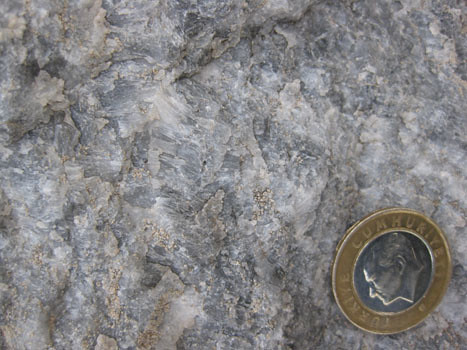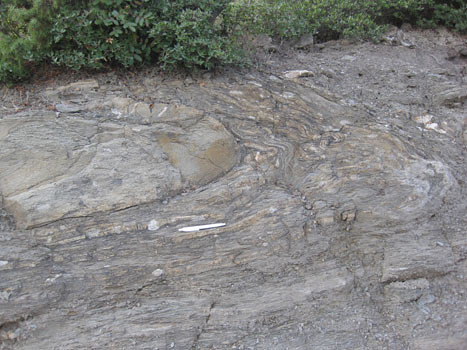In the 1987 comedy Planes, Trains, and Automobiles, John Candy and Steve Martin have a funny experience. It involves a cozy hotel room (one bed only) and the two travelers are huddled up for warmth. As he wakes up, John Candy thinks he is warming his hand “between two pillows.” At hearing this, Steve Martin’s eyes pop wide open, and he yells, “Those aren’t pillows!”
They jump up, totally discombobulated. An awkward moment follows.
Well, it’s not quite as awkward, but I had a similar “those aren’t pillows” moment recently. I was out in Shenandoah National Park with my GMU structural geology students, and we stopped off at the Little Stony Man parking area (milepost 39.1 on Skyline Drive). Here’s a figure showing the area in question, from Lukert & Mitra (1986):

You’ll note in the detail map at the right that it shows the nonconformable contact that separates the basement complex (here, the “Pedlar” Formation) from the overlying metabasalts of the Catoctin Formation.You’ll also note that it says “PILLOWS” with an arrow pointing at a specific spot on the trail. The word refers to basaltic pillows, which are breadloaf-shaped primary volcanic structures that form when lava erupts underwater. They are typically the size of a bedroom pillow (especially overstuffed pillows). Here’s some video of pillows erupting.
Pillows have been reported elsewhere in the Catoctin (e.g., near Lynchburg, according to Spencer, Bowring, and Bell, 1989), but this is the only location that I’m aware of where they have been reported in northern Virginia. The implications are not all that tremendous: just that a portion of the Catoctin erupted subaqueously, but it would be a neat thing to show students, especially seeing how close the outcrop is to safe parking.
Well, I’ve been to this area a half-dozen times, and I’ve never been able to find those damn pillows. It’s frustrated me, but I had an additional impetus this time around: I ran into Jodie Hayob, the petrology professor from Mary Washington University, who was out there with her students for the day. First thing we said to one another? You guessed it: “Did you find the pillows?”
While the students ate their lunches, I went off downhill (to the west), exploring and looking for these confounded pillows. Pretty soon, I found something that looked vaguely pillowy, at least in terms of have a well-defined “crust” with a dark interior (click through that link for a fine Canadian pillow, courtesy of Ron Schott). Prepare yourself for a lot of photos today… Here’s what I saw:

A few meters further downhill, I found another outcrop of the same stuff, this one veiled in a thin layer of algae (ahh, the joys of east coast geology!):

Little double-ridges which varied in parallel, defining small chunks of rock. Could these be the fabled pillows? But they’re …so small! They’re almost pincushions! I know they say size doesn’t matter, but it’s hard for me to picture a volume of lava this small hitting water and “inflating” to such a puny volume with a nice quenched glassy rind, but then having the interior to stay hot enough to crystallize into basalt. Hmmm. Starting to think something’s fishy with this subaqueous tale…
I then found a nice big cliff, 10 meters high and 20 meters wide, which was made of almost nothing but these structures. Here’s some of them highlighted by the sun (the boundary ridges weather out in high relief), despite being obscured beneath several layers of lichen:


A relatively clean, but relatively unweathered sample:

Aha, now that’s better:

The next two show more of a “classic” Catoctin coloring: chlorite green when fresh, with buff weathered surfaces on the outside:

Zooming in on one small, skinny purported “pillow”:

I climbed back up and coerced some students into joining me to check these weird things out, and they clambered down. Danny W. found a nice chunk of float which showed one of the “pillows” in three dimensions. Check it out at the top of this sample:

Three-dimensional extension courtesy of Photoshop; red line shows the long axis of this oblate ~ellipsoid plunging towards the camera. (Lara laughs in the background…)

Okay; two more… Check out how angular the boundaries of these “pillows” are:

Seeing this one really made me think: No way; “those aren’t pillows!“…

…Seeing that angular “break” on the left led me to realize that not only are these things too small* to be pillows, they also don’t have the right shape. Instead of being “pillowy,” (i.e., round) they are very angular, defined by edges that are aligned in a common direction and continue from one to the next.
* Where “too small” is defined as “smaller than anything Callan has seen before.”
I sketched in some of these planar edges:

To me, it looks like what’s happening here is that original homogeneous rock of the Catoctin Formation fractured, and then fluids flowed along those fractures, altering the rock that the fluids came into direct contact with. This produced the “double ridge” of buff-colored rock (on either side of the fracture), with the less-altered greenstone interiors being beyond the reach of these altering fluids. The intersection of the various joints and their subsequent boundary-defining alteration would look something like this example (from the online structure photo collection of Ben van der Pluijm): definitely click through to check it out.
In other words, I interpret these structures to be secondary, not primary. The end result is something that looks a lot like “boxwork” (again, please click through to get a sense of what I’m suggesting here): a phenomenon that occurs when limestone fractures, more resistant mineral deposits are precipitated in those fractures, and then the limestone blocks are dissolved away, leaving behind the “fractures” as planar ridges separating little “boxes” from one another.
Here’s two photos of boxwork, one whole-sample, one zoomed-in. This sample is in the USGS library in Reston, Virginia, and both photos were taken at my request by Bill Burton of the Survey. (Thanks Bill!)


At Little Stony Man, of course, the greenstone hasn’t “dissolved” away, but it does appear to be weathering more rapidly than the resistant buff-colored edges to these blocks, producing a distinctly boxwork-like effect.
Let’s look back at some of my field photos again, this time with the pillow boundaries highlighted in red…








(…I definitely could have hit a few more boundaries on that last one; forgive me for being haphazard and slapdash…)


This exercise convinced me that these things are not pillows, but some sort of fluid-rock interaction effect that took place on a complex fracture network. There’s no reason for the sharp edges of two adjacent pillows to be perfectly parallel and aligned.And it strains credulity to imagine ultra-tiny pillows in the first place (the size of my fingernail? Come on!).
I’ve e-mailed one of the authors of the original paper claiming pillows in this area with a link to my photos asking if these things are what he and his co-author were referring to, but I haven’t heard back anything. (I’ll update this post if he responds.) I might be totally off base here, but I can see how someone could make the claim that these were pillows. It’s just not a claim that convinces me, based on these outcrops.
What do you think? Do these look like any pillows you’ve ever seen?
__________________________________________
References:
M.L. Lukert and G. Mitra (1986). “Extrusional environments of part of the Catoctin Formation.” Trip #45 in Geological Society of America Centennial Field Guide – Southeastern Section, pp.207-208.
E.W. Spencer, C. Bowring, and J.D. Bell (1989). “Pillow lavas in the Catoctin Formation of Central Virginia.” in Contributions to Virginia geology, volume VI. Virginia Division of Mineral Resources publication 88, pp. 83-91.
Filed under: basalt, blue ridge, geology, joints, metamorphism, national parks, neoproterozoic, primary structures, structure, unconformities, virginia, weathering | 1 Comment »




































































